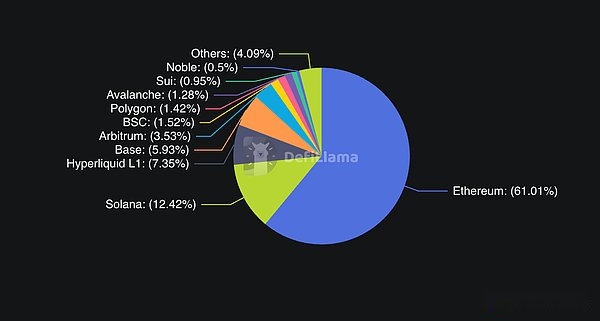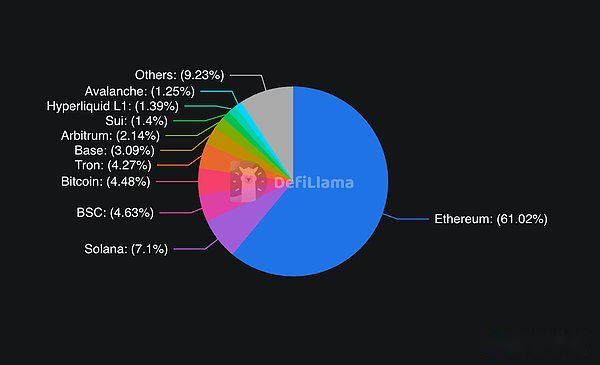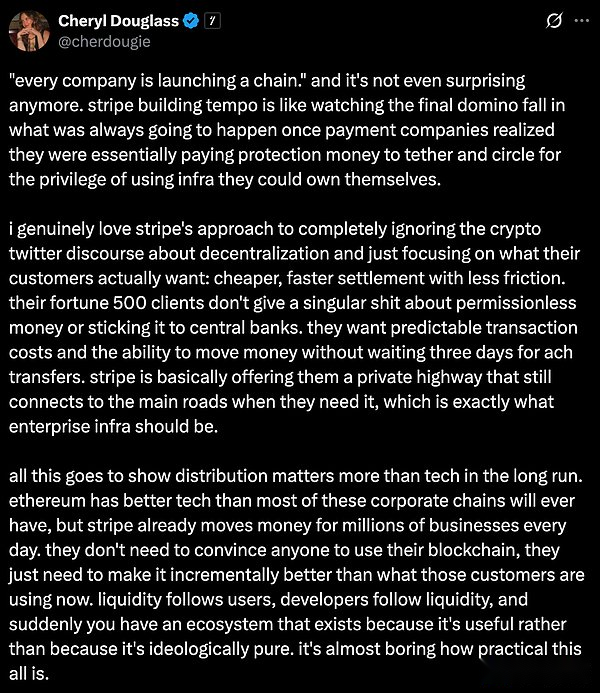
Author: Thejaswini, Source: Token Dispatch
Have you ever had this experience?At first, I bought a few Philips Hue smart bulbs out of simple intentions because they claim to be the best.The application interface is cool, the colors are amazing, you feel like a technical wizard, and you can dim the lights with your phone, which is very cool.
Then, you think the thermostat should be smart, but Nest’s AI is the best, so you bought it too.Different applications and different accounts, but it doesn’t matter, just one more.

Before you knew it, you were in chaos.
Your Ring doorbell doesn’t talk to your Alexa speaker, the speaker can’t control your Apple HomeKit garage door, and the garage door can’t communicate with your Samsung SmartThings hub.You need to use four different applications to turn on the light, adjust the temperature and lock the door.Every company promises to give you a “seamless smart home experience.”
But somehow, the house you lived in was more “stupid” than before, because there were a lot of “applied applications”.
Do Circle and Stripe do the same thing in the crypto world?
In August 2025, two major news came.
First, Stripe, a payment giant worth $50 billion, announced that it will cooperate with crypto venture capital firm Paradigm to build a “high-performance, payment-centric” blockchain called Tempo.
One day later, Circle, which owns $67 billion USDC stablecoins, also announced its Arc plan, a self-owned Layer 1 blockchain designed for stablecoin payments, forex and capital markets.
Circle’s Arc internal parsing:
Circle will build Arc specifically for their USDC stablecoin.Most blockchains require you to pay transaction fees with their native tokens, such as ETH on Ethereum, or SOL on Solana.On Arc, you can pay for the fee directly with USDC without having to hold volatile tokens.
Arc has a built-in exchange rate engine.You don’t need to use external services or decentralized exchanges (DEXs) to exchange currencies, Arc can handle exchange rates natively at the protocol level.You send USDC, the payee receives EURC (Euro Stablecoin), the conversion is automatically completed, no third-party services and additional fees.
Then comes privacy controls.Most public chains (Ethereum, Bitcoin, Solana) will display all information: address, amount, time.Privacy coins like Monero hide everything by default.Arc provides optional privacy, allowing institutions to hide transaction amounts, but keep the address visible, and has built-in compliance features.It is designed for businesses that require competitive privacy but do not want to be completely anonymous.
Stripe’s Tempo internal parsing:
Stripe’s differentiation lies in the abstraction of user experience.When other crypto payment solutions still have a strong “crypto flavor” (connecting to a wallet, signing a transaction, waiting for confirmation), Tempo’s design goal is to make blockchain payments look exactly the same as credit card payments in the eyes of users.
Compatibility with Ethereum means it can leverage existing DeFi infrastructure and developer tools, but its biggest advantage is its integration with Stripe’s existing merchant ecosystem.Millions of businesses using Stripe can easily add crypto payments without changing their checkout process or learning new systems.
Most importantly, Stripe’s existing banking and regulatory relationships can solve a big problem.Most crypto payment solutions struggle to move “the last mile” — transferring funds from blockchain back to bank accounts.And Stripe already has these partnerships, which is exactly what other crypto companies will take years to build.
Why do I feel confused?
So we returned to my fragmented smart home, and the problems began to multiply like the notification bar of various smart home applications on my phone.
The first thing that bothers me is:What is the demand for these dedicated blockchains?
Circle and Stripe have been talking about stablecoin payments and enterprise-class features, but the real active zone of stablecoins is in DeFi.
People use USDC to buy other crypto assets, participate in lending protocols, trade on decentralized exchanges, and interact with the broader ecosystem of financial applications.And all this mainly happens on Ethereum.

I feel like building the world’s most advanced smart thermostat, but it only works for houses without any other smart devices.
Of course, this thermostat may be technically superior, but you isolate yourself from the entire ecosystem where people really want to use smart home features.
The second question:Why do you need to make a repetitive invention?
All the features mentioned by Circle and Stripe—faster transactions, lower fees, custom features, corporate brands—can be achieved through the Ethereum Layer 2 solution.In this way, you can not only have the security of the underlying Ethereum network, but also access the largest DeFi ecosystem, and customize the network as needed.
Some Layer 1 blockchains have figured it out.Celo, which initially focused on mobile payments, was once an independent blockchain, but later announced plans to transform into Ethereum Layer 2.After some calculations, they realized that being part of the Ethereum ecosystem makes more sense than building their own network effects from scratch.
The more chains, the more bridges you need.And the bridge is where the problem occurs…
They are responsible for transferring assets between different blockchains, essentially complex smart contracts, locking your tokens on one chain, and then minting equivalent tokens on another chain.But the bridge is often hacked.We are not talking about the inconvenience of switching between Philips Hue and Nest applications, but the potential financial losses that may be caused by the bridge software error.
Bad user experience.The worst case scenario in my smart home is that I have to turn on another app to turn off the lights in the living room corridor.
But for enterprise blockchains, users may need different wallets, different gas tokens, different interfaces and different security settings.It’s already hard for most people to manage a crypto wallet.Imagine you also have to explain to them why Stripe payments and Circle transfers require different wallets.
But what puzzles me the most is thatThe network effect does not exist at all.
The value of a payment network will grow exponentially as users and applications increase.Ethereum has the largest number of developers, the largest number of applications and the highest liquidity.As of mid-2025, Ethereum’s TVL (total locked value) was US$96 billion, accounting for approximately 60-65% of all DeFi activity.Solana, often positioned as a high-performance alternative, has a TVL of $11 billion.Other mainstream chains such as Binance Smart Chain ($7.35 billion), Tron ($6.78 billion) and Arbitrum ($3.39 billion) split the rest.

These enterprise chains choose to break away from the existing network effect to build an isolated network, and naively hope that users can come to the door automatically.
Would you choose to open the perfect store on a deserted island?Of course, countries like the UAE built cities like Dubai and people did go.But that’s because of physical limitations, they have to do it.
Finally, there is another competitive problem that no one wants to face directly.Do these companies really want to build better infrastructure, or just don’t want to share their territory with their competitors?
Looking back at my smart home is a mess, every company has a reasonable choice of technical reasons.But the real driving force is that they don’t want to rely on other people’s platforms or don’t want to pay their competitors.
Maybe this is what really happened.Circle doesn’t want to pay Ethereum’s transaction fees, and Stripe doesn’t want to build on infrastructure that they can’t control.This is fair.But we should face it all honestly.It’s not about innovation or user experience, but about control and economic interests.
The King doesn’t seem to be worried
Ethereum seems to be calm about this and is not troubled.The network continues to process more than one million transactions a day, accounting for most of DeFi activity and obtains huge institutional inflows through its ETFs.One day in August, the net inflow of Ethereum ETF reached $1 billion, which is more than the total inflow of Bitcoin ETF the week before.
The Ethereum community’s reaction to these enterprise chains is also interesting.Some see it as a recognition.After all, both Arc and Tempo are building EVM-compatible chains, which essentially adopts Ethereum development standards.
But there is a subtle threat here.Every USDC transaction that occurs on Arc instead of Ethereum is a fee income that Ethereum validators cannot obtain.Every Stripe merchant payment processed on Tempo instead of Ethereum Layer 2 is an activity that does not contribute to the Ethereum network effect.
Solana may feel this competition more truly.The network has always positioned itself as a high-performance alternative to Ethereum, especially in payments and consumer applications.When major payment companies choose to build their own chains rather than adopting Solana, this undermines the argument that Solana has been promoting that “everything can be packed in a high-speed computer”.
Corporate blockchain cemetery
History is not friendly to companies that try to build their own blockchain.As I mentioned earlier, Celo made the same move in 2023.
Do you still remember Facebook’s Libra?This ambitious plan to create a global digital currency eventually turned into Diem, which disintegrated under regulatory pressure and was sold.Don’t forget that if there is a GENIUS bill that clearly defines how stablecoin issuers should operate in today’s regulatory environment, Facebook’s project might really be successful.
JPMorgan’s attempt at blockchain is perhaps the most relevant cautionary tale.The bank spent years building JPM Coin (a digital dollar), Quorum (their private blockchain network), and other blockchain projects.Despite having nearly unlimited resources, regulatory relationships and a large existing client base, these projects have never received meaningful adoption outside of JPMorgan’s own business.JPM Coin handles billions of dollars in transactions, but mainly transfers funds between the bank’s own institutional clients.
Even the attempts of major payment companies are not so inspiring.PayPal launched its own stablecoin PYUSD in 2023, becoming the first major U.S. fintech company to enter the stablecoin field.But PayPal did not build a custom infrastructure, but chose to issue it on existing networks such as Ethereum.What’s the result?
PYUSD has a market capitalization of only $1.102 billion, which is insignificant compared to USDC’s $67 billion and is primarily limited to PayPal’s own ecosystem.
This begs the question: If a company with a huge influence and payment expertise like PayPal cannot make a significant impact by relying on a stablecoin alone, then what makes Circle and Stripe think that building the entire blockchain would be better?
This model shows that building a successful blockchain requires more than just technical capabilities and financial resources.You also need network effects, developer enthusiasm and organic adoption, which are notoriously difficult to create out of thin air, even with large companies’ endorsements.
Will the situation be different this time?
We have reason to think that Circle and Stripe may succeed where other companies fail.
First, the clarity of supervision has been greatly improved.The GENIUS Act passed by the United States creates a clear framework for stablecoin issuers, eliminating much of the uncertainty that plagued early corporate blockchain attempts.When Circle launched Arc, they were not operating in the legal gray area, but a listed company operating under a set rule.
Second, both companies have what JPMorgan lacks: a large existing user base, and those users are not primarily from crypto-native groups.Stripe processes more than $1 trillion in transactions for millions of merchants around the world every year and has been systematically building its crypto infrastructure—for $1.1 billion, and then Privy (crypto wallet technology) to create an end-to-end payment stack.Circle’s USDC has been integrated into hundreds of applications and trading platforms.They are not blindly building chains, but building infrastructure for the user groups they already serve and having tools that can seamlessly guide them into the market.
When Paradigm’s Matt Huang described Stripe’s approach, he emphasized how blockchain technology can “retreat behind the scenes” and leave ordinary users feeling unconscious.
Imagine that when you pay online, you get instant checkout, lower fees and programmable capabilities, but the merchant’s checkout interface looks exactly the same as the existing Stripe checkout process.This is a completely different proposition from asking people to download MetaMask and manage mnemonics.This is the user experience of Web2, the underlying architecture of Web3.Users can’t even feel anything “blockchain”.
Third, the technology itself is mature.When JPMorgan tried blockchain in 2017-2018, the infrastructure was really primitive.Today, although it is still challenging to build a high-performance blockchain with institutional-level capabilities, it is no unprecedented.Circle acquired the team behind Malachite’s consensus engine, bringing it a technology that has been tested in practice and can achieve sub-second finality.Stripe’s partnership with Paradigm complements its payment expertise with deep crypto expertise.
The cost dynamics have also changed dramatically.In 2017, launching a new blockchain usually costs $1 million to $5 million, with a development cycle of up to 1 to 2 years or even longer.By 2025, the average cost of launching a functional blockchain application is $40,000 to $200,000, with a typical timeline of 3 to 6 months, thanks to improvements in developer tools, consensus engines and blockchain-as-a-service platforms.Due to efficiency improvements and infrastructure expansion, modern deployments in some areas are even 43% less expensive than centralized applications.
Payment companies realize they have been paying for infrastructure they could have built on their own.Rather than paying Circle’s USDC transaction fees, or relying on Ethereum’s fee structure, companies like Stripe can now build their own infrastructure for a small portion of the cost, which is much lower than what they pay to third parties in the long run.
This is the classic “Build vs. Buy” decision, and now the cost of the “Build” option has dropped from millions to hundreds of thousands.

The problem of coexistence
So, where will all this take us?Will we move towards a fragmented future where every big company runs its own blockchain?Or will market forces drive integration and interoperability?
Early signs suggest pragmatic coexistence rather than winner-take-all competition.Circle has made it clear that Arc will be a complement to its multi-chain strategy, not a replacement.USDC will continue to run on Ethereum, Solana and dozens of other networks.Arc is positioned to provide an additional option for users who need their specific features such as organizational privacy, guaranteed billing time, or built-in Forex features.
Stripe’s approach seems to be similar.Tempo is not intended to completely replace existing payment tracks, but rather provides alternatives to those use cases where blockchain capabilities can bring obvious advantages.Cross-border payments, programmable currencies and merchant settlement are areas where blockchain technology can truly surpass traditional systems.
Ultimately, user experience will determine whether this fragmentation becomes an advantage or a question.If the “chain abstraction” technology evolves as promised, users may interact with all these different blockchains without knowing or caring.Your payments app may automatically select a network that provides the best speed and cost for a particular transaction.
My prediction (if I can be a little optimistic):We will see two results happening simultaneously, but exist in different market segments.
For institutional and enterprise users, multiple specialized blockchains may flourish.When a multinational company transfers $100 million between subsidiaries, they are concerned about compliance capabilities, settlement assurance and integration with existing financial systems.They don’t care whether gas prices fluctuate, whether their blockchain has the coolest NFT projects, or the most active DeFi protocol.A chain that allows companies to withdraw funds directly to traditional banking systems, provide built-in compliance reports or guarantee settlement time will be more popular than Ethereum’s general infrastructure.
Arc may really serve these users better than Ethereum.
Stable fees, instant billing and built-in compliance capabilities may be more important for CFOs than accessing the latest DeFi protocols.
For retail users and developers, network effects will continue to be crucial.The blockchain with the most applications, the strongest liquidity and the most active developers will continue to attract more people to join.Today is still Ethereum, and these enterprise chains do not seem to be planning to directly challenge their dominance.
The biggest uncertainty is whether these enterprise blockchains will always focus on enterprises.If Stripe makes merchants pay faster and cheaper, and customers don’t realize they are using blockchain, it could grow beyond enterprise use cases.
But the essence of infrastructure is: the best things are invisible.When you turn on the light switch, you won’t think of power plants or transmission lines.When these blockchain experiments succeed, that will be because they completely disappear from the underlying technology.
Whether this will actually happen remains to be seen.For now, we are in the stage of land grabbing, and everyone wants to gain a place in the financial infrastructure of the future.







